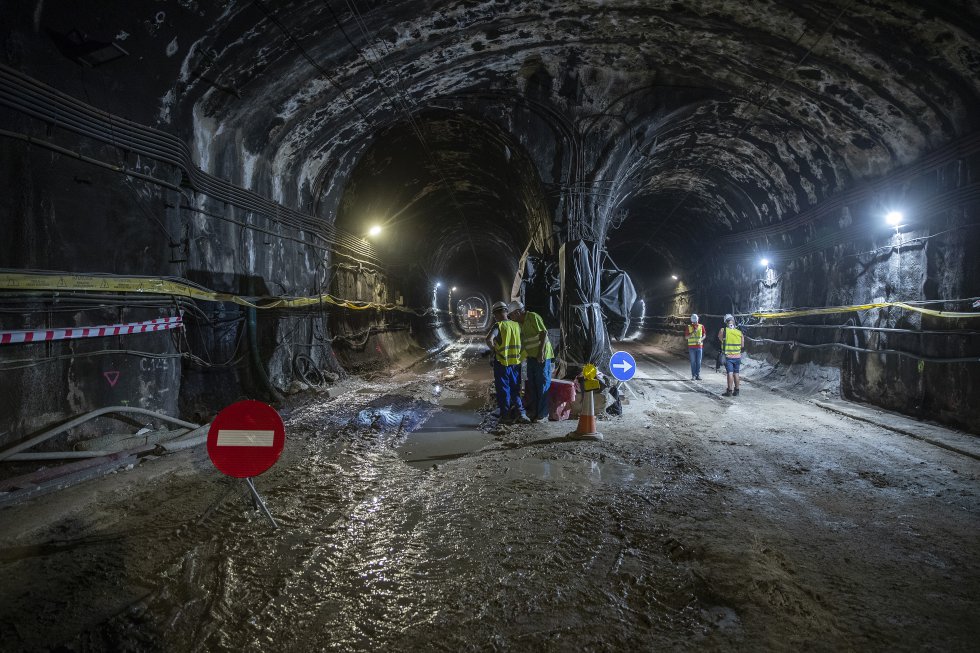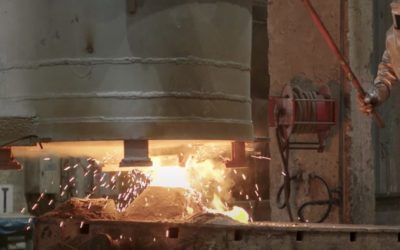The amount awarded by Adif to Amurrio amounts to 4.82 million euros
The works for the renovation of the Recoletos Tunnel are progressing at a good pace, and Amurrio Ferrocarril y Equipos has already supplied part of the contracted track equipment.
On July 25th the newspaper El País published a report on the work that we reproduce below, for the interest that we believe have both the text and the spectacular images.
The ‘tunnel of laughter’ gets a makeover
The subway that links Atocha and Chamartín receives its first major overhaul since its opening in 1967.
F. JAVIER BARROSO
Madrid 25 JUL 2019 – 10:38 CEST
While thousands of cars suffer traffic problems on the Prado, Recoletos and Castellana avenues, time almost stands still a few meters below. A universe of dust, large machines and brick vaults is hidden underground, where some 130 workers toil in this world of low lights and echoing noises. They are in charge of bringing into the 21st century the section with the highest traffic density in Spain, with an average of 470 trains and 200,000 passengers a day, mostly from the Cercanías network.
The so-called tunnel of laughter, which connects the stations of Atocha and Chamartín, receives its first major renovation since it was opened in 1967. More than half a century has passed and now Adif is giving it a major facelift. The floor on which the tracks, catenary and safety systems are laid is being replaced. In total, 45 million euros and the traffic will be cut off until November.
Work on the tunnel began in 1933, but due to the vicissitudes of history it was not completed until 1967. The name given to the tunnel by the people of Madrid has two theories. One, because it resembled the fairground attraction of the laughing train. Another, more feasible, is that it was a laugh the time it took to finish. In fact, several techniques were used, which are easily seen when you look at the different sections (dimensions) of the subway.
Since its opening, it has been one of the busiest railway sections. It connects the two most important stations in the capital. That high and continuous traffic have only allowed for punctual reforms or the repair of breakdowns. Between 2014 and 2018, 225 incidents were recorded on this section, with an average of 28 trains affected and 316 minutes of delay in each breakdown.
The tunnel retained the ballast, those stones on which the tracks were laid. «Thirty-five thousand cubic meters of this material have been removed and 15 kilometers of track have been lifted in pairs,» explains the manager of Adif’s Central Infrastructure Area, Abel Rajo. This material has been moved to the old O’Donnell station, where it is being reclassified in case it can be reused.
The activity in the tunnel does not stop. Work is going on 24 hours a day, seven days a week. The aim is to reduce delays so that the Sol tunnel does not have to be used for commuter trains for much longer.
In the midst of large puddles, a group of surveyors measures that the tracks are properly aligned. Other workers are busy laying the new surfaces that will house the tracks. In fact, 23,000 cubic meters of concrete will be used. On the busiest days, up to 150 concrete mixers a day are coming in. «The works are going at a good pace and we are saving the problems that are arising, such as some water leaks or the removal of the soil on which the ballast settled to put a thicker concrete,» highlights Rajo. «The traveler will notice from now on better service, similar to that of the Sol tunnel,» he adds.
At the back of Recoletos station, workers with a pneumatic hammer are working hard to break up an area where water is accumulating, while two excavators are digging into the ground. «Come on, at this rate we won’t finish,» shouts one of them to the rest, while they are bailing out the accumulated water.
The reform also includes replacing the current flexible catenary with a rigid one. This will cause fewer breaks and, therefore, fewer breakdowns. Safety measures will also be reinforced, which will facilitate evacuation in case of emergency.
Source: EL PAÍS, 25 de julio 2019
Photographs JULIÁN ROJAS




